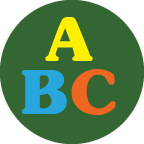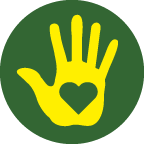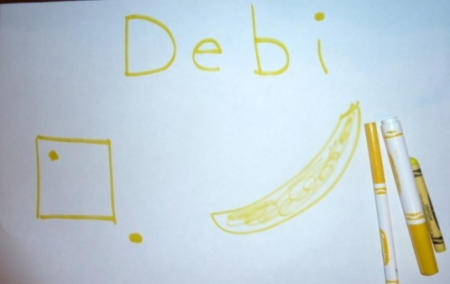Making A Yellow Placemat
Drawing, listening and following directions
Instructions

- A child will make a placemat to use for the yellow meal (Month 1 Activity 26)
- Select a large sheet of white paper to use as a placemat
- Ask the child to write his name with a yellow crayon/marker on the placemat
- Ask the child to draw 1 yellow square on the placemat
- Ask him to put a yellow dot in the square
- Ask him to put a yellow dot out of the square
- Ask the child to draw a picture of a yellow food (banana, cheese, grapefruit, yellow pepper, etc.)
- Next, encourage the child to finish decorating the placemat in their own way with the yellow crayon/marker
Simplify
When instructing the child where to draw with the yellow crayon, have your own white paper and yellow crayon to make a placemat alongside the child. Watching and talking together about where to write your name, draw a square, etc. helps a young child to visualize.
Extend
After the child has followed your directions for the placemat, encourage the child to state what and where he will draw an object on the placemat. For example, the child states I will make the numeral 1 with my yellow crayon in a square.
QUESTIONS FOR CHILD
Why do we use placemats on a table?
Can you tell me your favorite yellow food?
Is there a color of food you don't like to eat and why?
Materials
- white paper
- yellow crayon/marker
Curriculum Plan Resources
Skills Focus
- Shape - Square
- Color - Yellow
- Number - One, 1
- Alphabet Letter - A, E
- Senses - Touch
- Character Trait - Caring
- Target Words - In, Out, Empty, Full
Monthly Proverb
Swedish - The best place to find a helping hand is at the end of your own arm.
Did You Know?
Children who are not ready for kindergarten often have trouble succeeding in school. Those who do poorly in school are more likely to need to repeat classes, need special education, drop out of school, become teen parents, and get into trouble with the law. As adults, drop-outs have trouble making a living wage, and are at risk of poverty and homelessness
From Plan for the Washington Early Learning System – Draft 12/1/09 (Bill & Melinda Gates Foundation, 2005; Isaacs, 2008).
Books to Read
"The Mitten"
by Jan Brett (Activity 22)
"Little Blue and Little Yellow"
by Leo Lionni (Activity 8)
"How Kind"
by Mary Murphy (Activity 12)
"Little Blue and Little Yellow" VIDEO
by Leo Lionni (Activity 8)
"The Mitten" VIDEO
by Jan Brett (Activity 22)
"How Kind" VIDEO
by Mary Murphy (Activity 12)
Music Playlist
"The Hokey Pokey"
by Music for Little People Choir from album Toddlers Sing Playtime (Children) (Activity 14)
"Sonata for Two Pianos in D Major, K448 II."
Andante by Alicia de Larrocha from album Mozart: Concerto & Sonata for 2 pianos (Classical) (Activity 20)
"ABC (The Alphabet Song)"
from album Dora the Explorer (Children) (Activity 1)
"The Hokey Pokey" VIDEO
by The Learning Station (Activity 14)
"Sonata for Two Pianos in D Major, K448, II. Andante" VIDEO
by Mozart (Activity 20)
"ABC (The Alphabet Song" VIDEO
by Dora the Explorer
Monthly Materials List
Click Here to view the list!
Fingerplay / Poems / Songs
Select one poem for child to memorize this month and recite it at bedtime plus one song/fingerplay to learn. Here are two examples:
My NAME Song
(Activity 25 Month 1 - Sung to tune of BINGO)
There was a family had a child
and Carly (insert child's name) was her name.
C - A - R - L - Y C - A - R - L - Y C - A - R - L - Y (spell child's name)
And Carly (insert child's name) was her name
Kind To Others
(Activity 13 Month 1 - Fingerplay)
5 little children
Standing in a row ( hold up 5 fingers)
They are kind to others
Everywhere they go. (walk hand in front of body)
I am one of the children (point to self)
Standing in a row (hold up 5 fingers)
I'll be kind to others (point to self)
Wherever I go. (walk hand in front of body)
(This fingerplay works as a reminder to a child to be kind in any situation- without saying a word. Just walk hand in front of body to silently signal a child to remember to be kind or use actual sign language for the word kind.)




